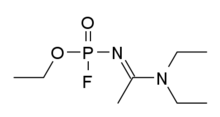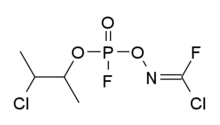A-234 (nerve agent)
A-234 is an organophosphate nerve agent. It was developed in the Soviet Union under the FOLIANT program and is one of the group of compounds referred to as Novichok agents that were revealed by Vil Mirzayanov.[1][2][3][4] In March 2018 the Russian ambassador to the UK, Alexander Yakovenko, claimed to have been informed by British authorities that A-234 had been identified as the agent used in the poisoning of Sergei and Yulia Skripal.[5] Vladimir Uglev, one of the inventors of the Novichok series of compounds, said he was "99 per cent sure that it was A-234" in relation to the 2018 Amesbury poisonings, noting its unusually high persistence in the environment.[6]
 | |
| Names | |
|---|---|
| IUPAC name
ethyl N-[(1E)-1-(diethylamino)ethylidene]-phosphoramidofluoridate | |
| Other names
N-2-diethylaminomethylacetamidido-ethoxyphosphonofluoridate | |
| Identifiers | |
3D model (JSmol) |
|
| ChemSpider | |
PubChem CID |
|
| |
| Properties | |
| C8H18FN2O2P | |
| Molar mass | 224.216 g·mol−1 |
Except where otherwise noted, data are given for materials in their standard state (at 25 °C [77 °F], 100 kPa). | |
| Infobox references | |
According to a classified report by the United States Army National Ground Intelligence Center,[7] the agent designated as A-232 and its ethyl analog A-234, developed under the FOLIANT program, "are as toxic as VX, as resistant to treatment as soman, and more difficult to detect and easier to manufacture than VX". Of the agent's binary versions, one is reportedly formed by acetonitrile and an organic phosphate "that can be disguised as a pesticide precursor," while for another, Bill Gertz wrote, "soldiers need only add alcohol".
No certain data on toxicity exist but it is estimated that the median lethal concentration of A-234 is 7 mg/m3. This means that half of 70 kg men under slight physical activity - breathing 15 litres of air per minute - would die within two minutes of exposure. This equates to median lethal dose of 0.2 mg via respiration.[8]
Alternative structure
 | |
| Names | |
|---|---|
| IUPAC name
([(2-chloro-1-methylpropoxy)fluorohydroxyphosphinyl]oxy)carbonimidic chloride fluoride | |
| Identifiers | |
3D model (JSmol) |
|
| |
| Properties | |
| C5H8Cl2F2NO3P | |
| Molar mass | 269.99 g·mol−1 |
Except where otherwise noted, data are given for materials in their standard state (at 25 °C [77 °F], 100 kPa). | |
| Infobox references | |
An alternative structure for A-234 and the related Novichok agents has been put forward by Western chemical weapons experts such as Steven Hoenig and D. Hank Ellison.[9][10] These structures are supported by Soviet literature of the time and were tested as acetylcholinesterase inhibitors,[11][12][13] however Mirzayanov claims that a number of weaker agents developed as part of the Foliant program were published in the open literature as organophosphate pesticides, in order to disguise the secret nerve agent program as legitimate pesticide research.
References
- Mirzayanov, Vil S. (2008). State Secrets: An Insider's Chronicle of the Russian Chemical Weapons Program. Outskirts Press. ISBN 978-1-4327-2566-2.
- Vásárhelyi, Györgyi; Földi, László (2007). "History of Russia's chemical weapons" (PDF). AARMS. 6 (1): 135–146. Archived from the original (PDF) on 2018-03-14.
- Halámek, E.; Kobliha, Z. (2011). "Potenciální Bojové Chemické Látky". Chemicke Listy. 105 (5): 323–333.
- Peplow, Mark (19 March 2018). "Nerve agent attack on spy used 'Novichok' poison". Chemical & Engineering News. 96 (12): 3. Retrieved 16 March 2018.
- "Russian spy: What are Novichok agents and what do they do?". BBC News. 19 March 2018.
- Carroll, Oliver (6 July 2018). "Novichok inventor on Amesbury poisoning: 'I completely understand panic of those living in Salisbury'". The Independent. Retrieved 26 May 2020.
- Gertz, Bill (4 February 1997). "Russia dodges chemical arms ban". The Washington Times. Retrieved 26 May 2020.
- Franca, Tanos C. C.; Kitagawa, Daniel A. S.; Cavalcante, Samir F. de A.; da Silva, Jorge A. V.; Nepovimova, Eugenie; Kuca, Kamil (January 2019). "Novichoks: The Dangerous Fourth Generation of Chemical Weapons". International Journal of Molecular Sciences. 20 (5): 1222. doi:10.3390/ijms20051222. PMID 30862059.
- Hoenig, Steven L. (2007), Compendium of Chemical Warfare Agents, Springer, ISBN 978-0-387-34626-7
- Ellison, D. Hank (2008), Handbook of Chemical and Biological Warfare Agents (Second ed.), CRC Press, ISBN 978-0-849-31434-6
- Kruglyak, Yu. L.; Malekin, S. I.; Martynov, I. V. (1972). "Phosphorylated oximes. XII. Reactions of 2-halophospholanes with dichlorofluoronitrosomethane". Zhurnal Obshchei Khimii. 42 (4): 811–14.
- Raevskii, O. A.; Chapysheva, N. V.; Ivanov, A. N.; Sokolov, V. B.; Martynov, I. V. (1987). "Effect of Alkyl Substituents in Phosphorylated Oximes". Zhurnal Obshchei Khimii. 57 (12): 2720–2723.
- Raevskii, O. A.; Grigor'ev, V. Yu.; Solov'ev, V. P.; Ivanov, A. N.; Sokolov, V. B.; Martynov, I. V. (1987). "Electron-Donor Functions of Ethyl Methylchloroformimino Methylphosphonate". Zhurnal Obshchei Khimii. 57 (9): 2073–2078.